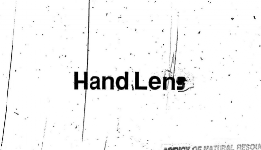
Issue №4: Check In
by W.L.
——
 While snow may remain on local ski-mountain Okemo and even the valley region received a half-inch of this morning, the living activity of spring is well underway. The last of the ice is gone from the glacial kettle bog, and the Eastern Newts have (a)roused.
While snow may remain on local ski-mountain Okemo and even the valley region received a half-inch of this morning, the living activity of spring is well underway. The last of the ice is gone from the glacial kettle bog, and the Eastern Newts have (a)roused.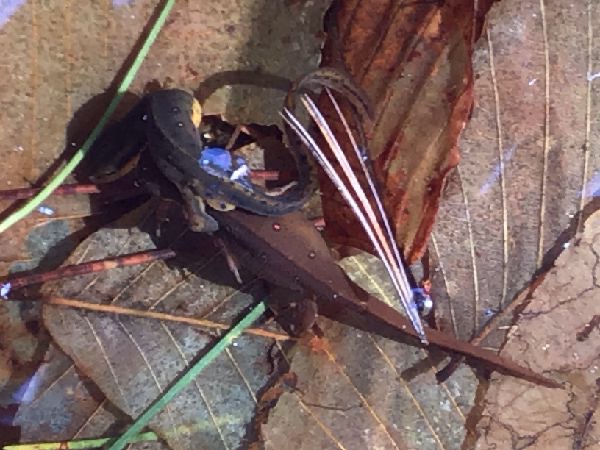 Here, a male is trying to entice a female into using the sperm packet it intends to drop to fertilize her eggs. Like with frogs, the male is gripping the female around the torso, under the front legs--but here the male uses the back legs, moving him far enough forward to bend into a U-shape so he can rub his face around the female's.
Here, a male is trying to entice a female into using the sperm packet it intends to drop to fertilize her eggs. Like with frogs, the male is gripping the female around the torso, under the front legs--but here the male uses the back legs, moving him far enough forward to bend into a U-shape so he can rub his face around the female's.Here is the pair after I accidentally disturbed them--note the continued grip.
 Disturbances, fortunately, are normal in this process. Even though they can remain underwater for multiple hours, adult newts must surface eventually.
Disturbances, fortunately, are normal in this process. Even though they can remain underwater for multiple hours, adult newts must surface eventually.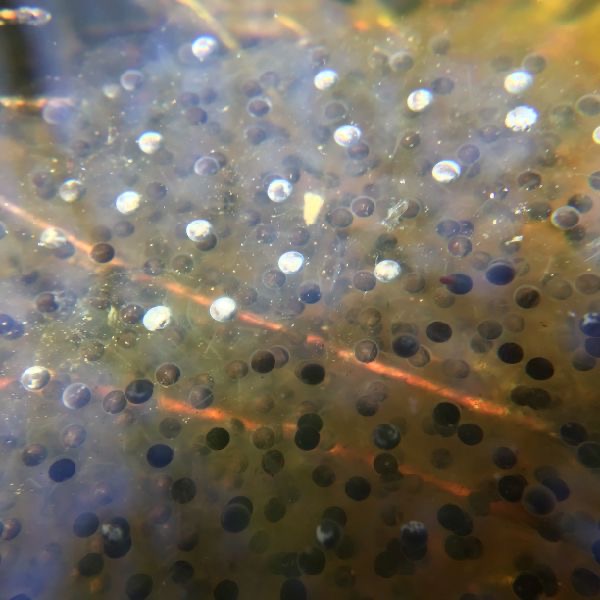 Most of the true vernal ponds have their eggs now. I noticed a mosquito larvae twitching back and forth by the eggs--presumably feeding on the small layer of algae that had formed around the mass. This may have been to the eggs' detriment--for some species, like the spotted salamander, the algae works as a respirator to the eggs, flushing excess carbon and providing oxygen as they develop.
Most of the true vernal ponds have their eggs now. I noticed a mosquito larvae twitching back and forth by the eggs--presumably feeding on the small layer of algae that had formed around the mass. This may have been to the eggs' detriment--for some species, like the spotted salamander, the algae works as a respirator to the eggs, flushing excess carbon and providing oxygen as they develop. The amphibians that emerge from those eggs will be well-fed.
The amphibians that emerge from those eggs will be well-fed. If they make it that far.
If they make it that far.

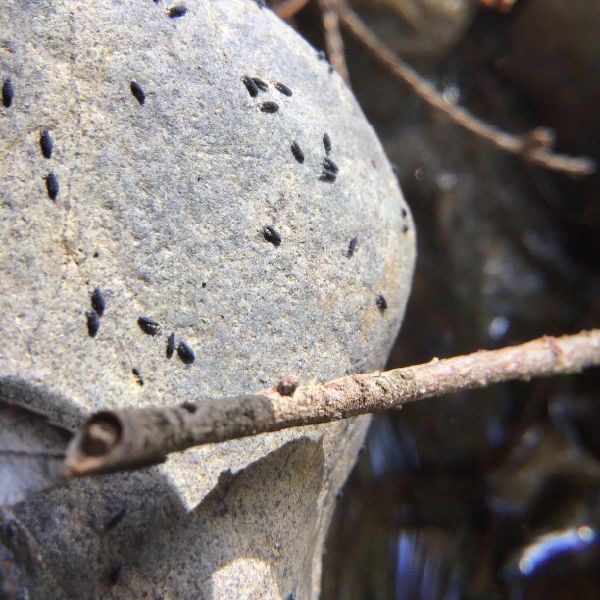 In the continuing misadventures of our springtail population, here are a group of springtails sunning on a rock near a stream.
In the continuing misadventures of our springtail population, here are a group of springtails sunning on a rock near a stream.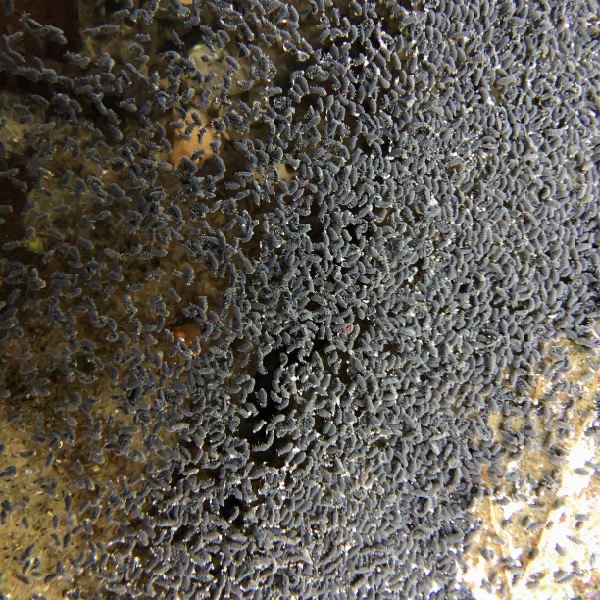 Here are the springtails in the stream--the risks of of being able to leap more than two orders of magnitude further than your body-length. Note, though, that most of these springtails appear to be handling the surface tension well--and indeed, as their furcula (the "spring tail") is hydrophobic, many of them could simply leap away should they choose to. I may, in fact, be mis-identifying these as terrestrial springtails that leapt into the water, as there are semi-aquatic springtail species!
Here are the springtails in the stream--the risks of of being able to leap more than two orders of magnitude further than your body-length. Note, though, that most of these springtails appear to be handling the surface tension well--and indeed, as their furcula (the "spring tail") is hydrophobic, many of them could simply leap away should they choose to. I may, in fact, be mis-identifying these as terrestrial springtails that leapt into the water, as there are semi-aquatic springtail species!
 Far from water's edge, a velvet mite crawls along the side of a split-open rotten log, hunting for prey a little smaller even than those springtail.
Far from water's edge, a velvet mite crawls along the side of a split-open rotten log, hunting for prey a little smaller even than those springtail. Five feet in the air, a spider hides among the buds of a red maple tree. Is it in the broad family of crab spiders? The hide-in-a-flower behavior certainly fits, as do the slightly-elongated and forward-sloping front limbs, but I certainly don't recognize it. My intent as I pulled the branch toward me was just to take a shot of the buds--only to have this spider come out from the cavity between them to face me. Sadly, I was too slow to line up my macro lens--evidently deciding I was not worth the attention, it turned its attention back to the bud.
Five feet in the air, a spider hides among the buds of a red maple tree. Is it in the broad family of crab spiders? The hide-in-a-flower behavior certainly fits, as do the slightly-elongated and forward-sloping front limbs, but I certainly don't recognize it. My intent as I pulled the branch toward me was just to take a shot of the buds--only to have this spider come out from the cavity between them to face me. Sadly, I was too slow to line up my macro lens--evidently deciding I was not worth the attention, it turned its attention back to the bud.

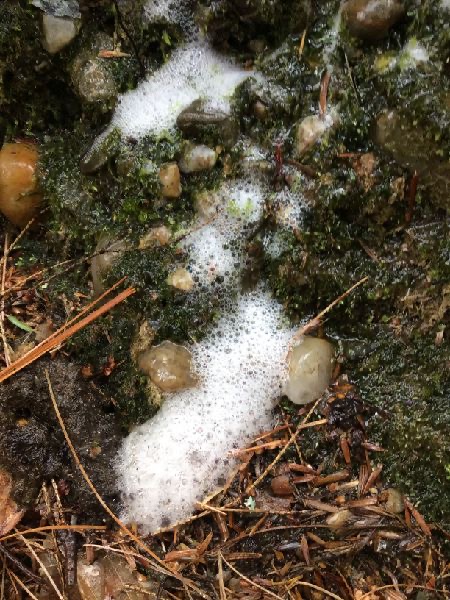 Unlike much of the foam on the surfaces of streams in developed areas, the foam collecting here in the moss at the base of a white pine clearly can't be a product of industrial or home detergents. Here, rain instead mixes with sap and any particulate on the tree in a fluid called "stemflow"--which, under the right conditions, can combine fatty substances in the sap with salts deposited by insects and dust to produce crude soaps
Unlike much of the foam on the surfaces of streams in developed areas, the foam collecting here in the moss at the base of a white pine clearly can't be a product of industrial or home detergents. Here, rain instead mixes with sap and any particulate on the tree in a fluid called "stemflow"--which, under the right conditions, can combine fatty substances in the sap with salts deposited by insects and dust to produce crude soaps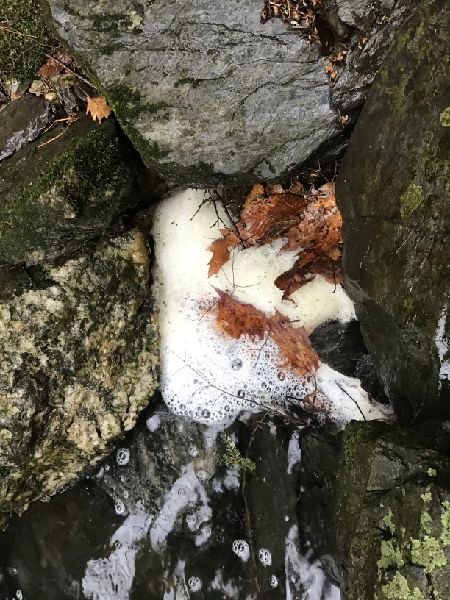 I suspect stemflow is a minor contributor to stream foam compared with human influences and with plant and especially animal decay--but the source I'd hoped to check this in is thoroughly paywalled, so.
I suspect stemflow is a minor contributor to stream foam compared with human influences and with plant and especially animal decay--but the source I'd hoped to check this in is thoroughly paywalled, so.Wood frogs' No. 1 option: Hold in pee all winter to survive:
"'Their eyes are white. Their skin is frosty. They're like little rocks. They're frozen,' Costanzo said."
From the paper:
"Digestive organs of amphibians undergo profound transformations in structure and function during adaptation to altered physiological and nutritional states in dormancy. Accordingly, the gastrointestinal tract of our hibernating frogs was reduced in mass (25%) and length (61%), and also in density (approx. 50%), perhaps owing to degeneration of the mucosa and musculature, particularly of the midgut. Remodelling responses vary among alimentary organs, as, for example, the hindgut is only slightly altered, whereas size of the foregut and/or midgut is reduced by 50–85% in estivating frogs and salamanders, and in hibernating toads. Results for our hibernating frogs were comparable. Selectively maintaining the hindgut’s morphology in dormancy despite the added energetic cost presumably benefits the host by providing symbiotic bacteria with diverse colonization niches."

——
